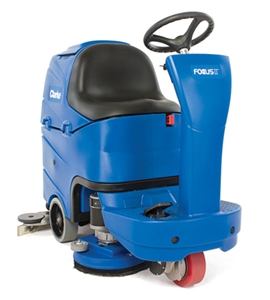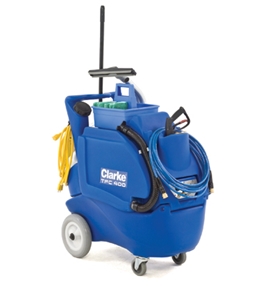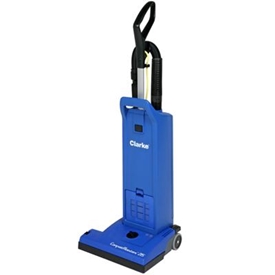For the past few years, the topic of sustainability and the green movement have taken a back seat to the economy. Even though customers understood the value of being an environmental steward and purchasing with a “green” intent, saving money trumped saving the environment. In other words, a sustainable green message temporarily was lost. The key word is temporary. Leadership in Energy and Environmental Design (LEED)-certified homes, products with the Green Seal of Approval, hybrid and electric automobiles, alternative energy solutions, recycling initiatives, water conservation strategies, among other sustainable solutions, are again making their way back into the news.
Rental houses have an opportunity to take advantage of green in a couple of product areas, including renting floor equipment that is designed to have a minimal impact on the environment. “Green is not a fad,” says Paul Albrecht, national account manager for Clarke Equipment. “The rental market usually follows what has become popular in professional applications. Hospitals and school districts especially are continually buying more products that are green, which means rental houses will likely see an increased demand in the same way.”
Read the full article here to learn about floor equipment solutions for rental houses.
Monday, July 30, 2012
Monday, July 23, 2012
Clarke Enters Focus® II MicroRider™ into ISSA Innovation Award Program
Clarke has entered the Focus® II MicroRider™ into ISSA’s 2012 Innovation Award Program.
The annual competition allows distributors and cleaning industry
professionals to vote to determine the industry’s most innovative
products and services in five unique categories, including: Cleaning
Agents; Disposables; Equipment; Services & Technology; and Supplies.
The Focus II MicroRider is entered into the “equipment”
category. Voting opened on July 16, 2012.
The Focus II MicroRider with BOOST® is everything you need in a compact rider. The unique SafetyGlide™ scrub deck automatically moves in line with the path of the rear squeegee when the steering wheel turns, resulting in 100 percent water pick-up and eliminating the need for side skirts. With BOOST technology, you can now effectively remove floor finish chemically-free in a compact rider scrubber.
To vote for the Focus II MicroRider, visit http://www.issa.com/vote.
The Focus II MicroRider with BOOST® is everything you need in a compact rider. The unique SafetyGlide™ scrub deck automatically moves in line with the path of the rear squeegee when the steering wheel turns, resulting in 100 percent water pick-up and eliminating the need for side skirts. With BOOST technology, you can now effectively remove floor finish chemically-free in a compact rider scrubber.
To vote for the Focus II MicroRider, visit http://www.issa.com/vote.
Monday, July 16, 2012
IAQ: Common Problems and Cost Saving Solutions
This article was originally published by American School & Hospital Facility
In schools, indoor air contaminants can either originate within the school building or be drawn in from the outdoors. If pollutant sources are not controlled, indoor air problems can develop, even if the HVAC system is properly designed, operated, and maintained. Sources of indoor air contamination include polluted outdoor air, underground sources (e.g., radon, pesticides, and leakage from underground storage tanks), and a variety of indoor sources (e.g., equipment, furnishings, and housekeeping supplies).
Concentration levels of air pollutants can vary greatly by time and location within a school building, or possibly a single classroom. Pollutants can be emitted from point sources, such as science storerooms, or from area sources, such as newly painted surfaces. And pollutants can vary with time, such as only when floor stripping is done. Indoor air often contains a variety of contaminants at concentrations that are well below any standards or guidelines for occupational exposure, so it can be difficult to relate specific health effects to exposures to specific pollutant concentrations, especially since the exposures may be to low levels of pollutant mixtures.
The IAQ problems that generally get the most attention are usually those that involve lots of complaints from staff and students. Issues can be exacerbated by allergic reactions and health issues. These often involve outdoor contaminants that are being entrained into the building with outdoor ventilation air, such as wood smoke. One of the most common issues involves vehicle emissions. Vehicle exhaust can be problematic when the school is located in an urban setting or near heavily traveled roads, such as a highway. And the exhaust from school buses, unloading b e f o r e and after school, can be a common culprit. For hospitals, special attention is required to clean the air of contaminants that may jeopardize patient safety. More outside ventilation air is commonly used in hospitals than in typical commercial spaces. Like schools, in many urban —and even many suburban—healthcare settings, outdoor air can be more problematic than indoor air.
Read the full article here.
In schools, indoor air contaminants can either originate within the school building or be drawn in from the outdoors. If pollutant sources are not controlled, indoor air problems can develop, even if the HVAC system is properly designed, operated, and maintained. Sources of indoor air contamination include polluted outdoor air, underground sources (e.g., radon, pesticides, and leakage from underground storage tanks), and a variety of indoor sources (e.g., equipment, furnishings, and housekeeping supplies).
Concentration levels of air pollutants can vary greatly by time and location within a school building, or possibly a single classroom. Pollutants can be emitted from point sources, such as science storerooms, or from area sources, such as newly painted surfaces. And pollutants can vary with time, such as only when floor stripping is done. Indoor air often contains a variety of contaminants at concentrations that are well below any standards or guidelines for occupational exposure, so it can be difficult to relate specific health effects to exposures to specific pollutant concentrations, especially since the exposures may be to low levels of pollutant mixtures.
The IAQ problems that generally get the most attention are usually those that involve lots of complaints from staff and students. Issues can be exacerbated by allergic reactions and health issues. These often involve outdoor contaminants that are being entrained into the building with outdoor ventilation air, such as wood smoke. One of the most common issues involves vehicle emissions. Vehicle exhaust can be problematic when the school is located in an urban setting or near heavily traveled roads, such as a highway. And the exhaust from school buses, unloading b e f o r e and after school, can be a common culprit. For hospitals, special attention is required to clean the air of contaminants that may jeopardize patient safety. More outside ventilation air is commonly used in hospitals than in typical commercial spaces. Like schools, in many urban —and even many suburban—healthcare settings, outdoor air can be more problematic than indoor air.
Read the full article here.
Monday, July 9, 2012
All-Purpose Cleaning
The TFC 400 is a powerful and versatile all-purpose cleaner. Charged with 400 psi of power-spraying punch, the TFC 400 cleaner gives you the ability to blast away grit and grime without actually having contact with the dirt. With the 20 gallon solution tank and 13 gallon recovery tank, the TFC 400 cleaner gives you the ability to tackle the really big cleaning jobs quickly and thoroughly.
Monday, July 2, 2012
Vacuuming During Day Cleaning
This article was originally published by Contracting Profits
If I want to use a vacuum for day cleaning: How quiet does it need to be?
In this article, industry manufacturers answer common questions asked by building service contractors.
The U.S. Green Building Council’s LEED certification requires that a vacuum be under 70 dBA in order to qualify for the IEQ credit. This should be sufficient for most schools and hospitals. In facilities where peace and quiet are critical, a vacuum with two modes can be used, a power mode for after hours cleaning, and a quiet mode that runs at just 51 dBA for daytime. A normal conversation is around 67 dBA, so these vacuums are practically invisible to building occupants.

— Jacalyn High, director of marketing, ProTeam, Boise, Idaho
At minimum, day cleaning operations require quiet, commercial-strength vacuums that operate below 70 decibels, so staff can clean day and night with less impact on the workers around them.
— David Parkes, general manager, Sanitaire, Charlotte, N.C.
This is dependent on the facility that is being cleaned. Every facility that goes to day cleaning wants a lower sound level, which all manufacturers are striving to achieve. The challenge is the trade off, since reducing sound levels also reduces cleaning effectiveness of the vacuum cleaner; in most cases, small motors and reduced air flow are required to achieve needed sound levels for day cleaning.
— Brad Nyholm, product manager: commercial/dealer for Hoover/Royal Brands, TTI Floorcare North America, Glenwillow, Ohio
Learn about Clarke carpet vacuum cleaning solutions at: http://www.clarkeus.com/products/carpetvacuums.aspx
If I want to use a vacuum for day cleaning: How quiet does it need to be?
In this article, industry manufacturers answer common questions asked by building service contractors.
The U.S. Green Building Council’s LEED certification requires that a vacuum be under 70 dBA in order to qualify for the IEQ credit. This should be sufficient for most schools and hospitals. In facilities where peace and quiet are critical, a vacuum with two modes can be used, a power mode for after hours cleaning, and a quiet mode that runs at just 51 dBA for daytime. A normal conversation is around 67 dBA, so these vacuums are practically invisible to building occupants.


— Jacalyn High, director of marketing, ProTeam, Boise, Idaho
At minimum, day cleaning operations require quiet, commercial-strength vacuums that operate below 70 decibels, so staff can clean day and night with less impact on the workers around them.
— David Parkes, general manager, Sanitaire, Charlotte, N.C.
This is dependent on the facility that is being cleaned. Every facility that goes to day cleaning wants a lower sound level, which all manufacturers are striving to achieve. The challenge is the trade off, since reducing sound levels also reduces cleaning effectiveness of the vacuum cleaner; in most cases, small motors and reduced air flow are required to achieve needed sound levels for day cleaning.
— Brad Nyholm, product manager: commercial/dealer for Hoover/Royal Brands, TTI Floorcare North America, Glenwillow, Ohio
Learn about Clarke carpet vacuum cleaning solutions at: http://www.clarkeus.com/products/carpetvacuums.aspx
Subscribe to:
Posts (Atom)




